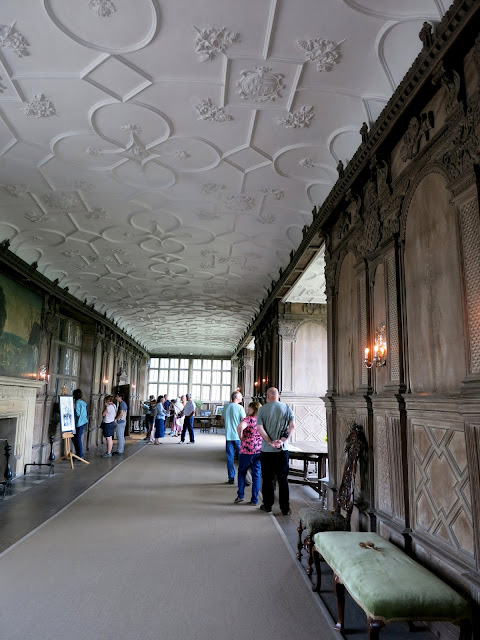 |
| View of Haddon Hall from the river bridge. |
The grand houses that are built later may have lavish furnishings, but somehow I find the medieval manor house of Haddon Hall, even more enchanting. It was used in the filming of The Princess Bride, as well as The Other Boleyn Girl, the 1996 version of Pride and Prejudice, and the 1998 filming of Elizabeth. It does have a fairy-tale quality about it, doesn't it?
 |
| Medieval window at Haddon Hall. |
The brother of the current Duke of Rutland lives there today, and the family sometimes entertains its guests in these rooms. Like many aristocrats, they open their home to the public for a fee, which helps offset the costs of maintaining these old buildings.
This detail in the ceiling of the dining room caught my eye...
It was a Tudor rose, the emblem of England that dates from the time of Henry VII, who united the white rose of York with the red Rose of Lancastershire when he took the throne, ending the War of the Roses between the two factions who had fought for the crown.
The grounds and gardens, full of roses, lavender, and other flowers provide a picturesque setting for
this medieval jewel.
But what really captured my attention was the kitchen and,
especially, the turnspit dogs.
 |
| Tudor fireplace and sign about turnspit dogs. I wish they had one of the wheels on display! |
I had never heard of turnspit dogs! A sign on the wall told
all about the breed. It is now extinct, but in medieval
times, the dogs were bred to run in a wheel at the side of a fireplace, not
unlike a hamster wheel, but larger of course.
The wheel turned the spit where large joints of meat rotated as they cooked over the fire, hence the name “turnspit dogs.” They were also called Vernepator Curs and “kitchen dogs." They had short, often crooked legs, and long bodies. (Talk about an
underdog!)
The dogs worked in teams and ran in the wheel for a specific
interval. According to the sign, the
dogs were very aware of how long their shifts were, and they would jump down if
they thought their time was up.
The poor little does were horribly treated. Of course, human servants were often treated cruelly then, too. The
one good thing that came from the plight of the turnspit dogs was that their
abuse helped inspire the formation of charities to prevent cruelty to animals,
such as the ASPCA.






The stories you tell - of how people and animals lived, and what they did and what happened to them - are the most interesting kind of history. Great story!
ReplyDeleteAlso, love the photos of Haddon Hall!
ReplyDelete